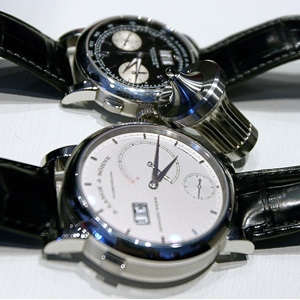|
One of the most daunting challenges in the development of any wristwatch is to provide it with a stable power supply during the mainspring winding. The wound spring provides a high power, and the going train receives the torque. As a result, the control element known as the balance receives intensive and clear energy impulses. a stable power supply during the mainspring winding. The wound spring provides a high power, and the going train receives the torque. As a result, the control element known as the balance receives intensive and clear energy impulses.
The problem of stable energy is especially acute for watches with a large power reserve. The torque of the often multiple mainsprings of greater dimensions may fluctuate considerably. At decreased energy, the energy impulses coming in the balance become weaker. Therefore, the angle of balance wheel lead can be reduced. The complete path between two dead spots of vibrations is called the amplitude. The amplitude contraction means the balance doesn’t deviate enough because of the lack of energy. And it results in inaccurate time reading, so all advantages of large power reserve lose their value.
Fortunately, A.Lange & Sohne manage to maintain the stable energy between windings: a so called fusée-and-chain transmission prevents the amplitude contraction. This mechanism using the lever principle is considered to be created by Leonardo Da Vinci some centuries ago. The fuséee consists of cone, co-axial with the central wheel, and chain, one end of which is attached to the barrel drum and the other to the cone. Without fusée and at power reserve exhaustion in the spring, the going train receives less torque, resulting in the reduction of power, coming to the running wheel. As a result, it transfers weaker impulses to the balance wheel, and it leads to the reduction of balance lead angle, i.e. of amplitude.
With fusée the spring’s tension, diminishing during the drum winding, is compensated by the increasing effect of chain on the cone. The former in turn send much torque to the going train that provides constant intensive impulses, coming to the running wheel. And the wheel correspondingly provides the balance with amplitude.
 Solving one problem, the fusée creates another one, as this construction requires place. The watches, three forth of which are taken by two big drums, simply don’t have place for the fusée. That’s why the Lange 31 model creators had to use a so-called remontoir - the constant-force escapement. It has the same effect on the release wheel and balance, as the fusée does – it assures the highest level of rate stability and rate accuracy, even if the spring’s tension is eased. Solving one problem, the fusée creates another one, as this construction requires place. The watches, three forth of which are taken by two big drums, simply don’t have place for the fusée. That’s why the Lange 31 model creators had to use a so-called remontoir - the constant-force escapement. It has the same effect on the release wheel and balance, as the fusée does – it assures the highest level of rate stability and rate accuracy, even if the spring’s tension is eased.
But unlike fusée, the constant-force escapement is wedged in the wheel system right before its start. Taking the going train energy, the constant-force escapement uses it for its own control element, which in its turn provides the running wheel and balance with stable energy. The wrist watches control element is made with the help of one spring (in big watches – with the system of poises and blocks).
To provide the high level of power reserve stability during all 31 days, A.Lange & Sohne used the constant-force escapement, having become the third company after the manufactories of Francois-Paul Journe and Jerome De Witt to use this complicated movement in its watches. However, the constant-force movements of Journe and De Witt ran the tourbillon carriage, and the A.Lange & Sohne mechanism is used in the standard watches and simply provides the high accuracy with the enormous power reserve. It means that A.Lange & Sohne was the first to find a true functional use for this mechanism in watches.
In the Lange 31 watches the pretensioned spiral spring of the constant-force movement is put on the axis of the fourth wheel. It is also called the second spring as the second hand is put on the same axis as well. Every 10 seconds the spring is being wound for 60 degrees. Due to the balance, the fourth wheel rotates uniformly and the constant-force movement spring is retightened on the fly at intervals of ten seconds. The constant-force movement itself consists of the cam of the equilateral triangle form with convex sides, also put on the axis of second wheel. Every 10 seconds the cam pushes the pivoting fork. The fork carries two pallets, fixed on the release wheel of the constant-force movement with one prong. This wheel through the gear wheel system connects with the double winding drum and, having turned at 180 degrees and caught the fork pallet by its prong, stops its rotation. During the wheel rotation, the winding drum energy is released, and in a fraction of a second it winds the constant-force escapement spring, which during the following 10 days gives its winding to the second wheel.
|
